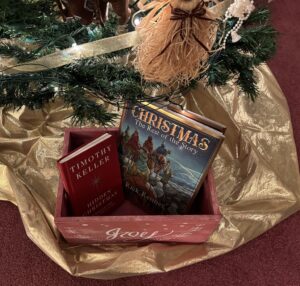It was a dark and stormy night. Definitely not a night to be separated from the comforts of home. The weary travelers shivered as they searched for the star that had guided them in the past. After all this anticipation, would they be late for the big event?
Then, a momentary pause in the heavy snowfall revealed its glow—and our friends pulled into our driveway just in time to visit our Christmas open house before it was over.

Every Christmas for the last few decades, we’ve had a lighted star that has occupied a spot high over the front porch. Occasionally our guests use it to distinguish our house at night during the holiday season. But now, as I write this, that bit of space is dark. Our star has burned out.
I have begun the search for a new one at the box stores. So far I have not found the perfect star, but I did spot a sweet-looking gift bow. I texted a picture to Bonnie. Her reply came at light speed. “Hmmm . . . ‘The wise men followed the big red bow with holly leaves that appeared in the sky.’”

I was stunned, but impressed, at her response. This would require some time and energy to deliver a quality comeback. For the time being, though, I texted “You’re funny”—husband code for “Think you’re funny, don’t you?”
When I got home with no star—or bow—I began some research about the Wise Men. Maybe I was grasping at straws, but what if they followed a star in the bow of the Archer or Hunter constellation. I could almost hear the humble touché.
I went to my favorite Christmas book—Christmas: The Rest of the Story, by Rick Renner. He might have something for me. Even if there was nothing to vindicate my bow idea, it’s an interesting read, partly because Renner offers so many other interesting tidbits that challenge the traditional images of the Christmas story.
For example, nowhere does the Bible say that the wise men, or Magi, were kings. There goes one of the Christmas carols. To be fair, though, the hymn writer wasn’t really that far off. “The early church historian Tertullian wrote that they were ‘well-nigh kings’ in many respects” (p. 179). They could make or break a king. That was one reason Herod was so troubled when they visited him in Jerusalem.
He wasn’t real happy about the prospect of a new king of the Jews, either. He’d occupied his throne in Jerusalem for three decades, and it had been no small task keeping it.
There’s more. The Bible doesn’t say there were three wise men. Some scholars even say there might have been up to a dozen. Apologies to the hymn writer again. I still love “We Three Kings.”
How did the Magi even know a new king would be born? Renner and some other scholars believe they were educated by Daniel, a Jewish captive of the Babylonians. At the same time, though, he was a high-ranking official under first Babylonian, then Mede and Persian kings. Daniel may have even become head of the Magi. That was a big deal, for they were the elite scientists, politicians, and religious leaders of their time. They witnessed fantastic miracles performed by the God of Israel while Daniel was in office. They began waiting and watching for a sign of the Messiah that Daniel had prophesied.

After they spotted the sign they’d been looking for, it took the Magi a while to journey to the king, several months to even a year or two. Right, they weren’t there in the manger that night Jesus was born. Besides travel time, they probably needed time to assemble gifts for the newborn king. More than just gold, frankincense, and myrrh. The Magi were fabulously wealthy. A freight caravan would have been required to haul all the bounty, accompanied by a small army to protect them and their cargo.
To me, that sign for the Magi, the “Star in the east” (Matthew 2:2), is the most interesting piece of the story. Some theologians say the Magi followed a planet, a constellation, or even a comet. It appears to others, though, that it would take a supernatural light for that kind of guidance. Kind of like the pillar of fire that the Israelites followed in the desert?
Herod sent the men to find the baby in Bethlehem, where he was prophesied to be born. But the star must have relocated on the way; they changed directions and traveled to Nazareth. That’s where Jesus and his family would have been by then (Luke 2:39).
Interesting as all that was, I found nothing in the way of bow stars. But they did follow a star so they could find and worship their new king and present him with gifts. I knew a gift bow figured in there somewhere.
This brings us to the question: What is it we look for on Christmas? Is it the star or is it the gifts. At first thought for me, especially thinking back to my childhood, it’s the gifts.
Funny thing is, after all my gifts were torn open and played with on Christmas Day, I had a bit of a sinking feeling. Is this it?
I guess it wasn’t really the gifts. It was the magic of anticipation. It was the fairy tale of Santa, the supernatural gift giver in red. He was my hero, immortal, spreading kindness throughout the world. And he could fly!

I wasn’t real excited that he was also the naughty monitor, though. How could I possibly know if I was being good enough to get the gifts?
It’s not just the fairy tale about Santa, though. According to Tim Keller in Hidden Christmas, all good stories touch us because they point us to the Christmas story. They scratch the itch for something great in our future. We can know a love we can never lose. We can triumph over evil. Our story has a perfect ending.
But the Incarnation is no fairy tale. That’s the good news! Even better news: Jesus doesn’t keep a naughty list; he keeps a followers list. (Whew!)
Followers of the star are part of the greatest story ever told. We gladly present our lives to him and worship him in return for the gifts of joy and peace and life that he brings.





Brenda Murphy
December 17, 2023That was interesting but it does mess with our fairytale story, lol. I like being a follower of the star, that’s cool. 🙂
CW Spencer
December 17, 2023Santa and a Christmas carol too. I guess I’ve caused enough trouble for one day.